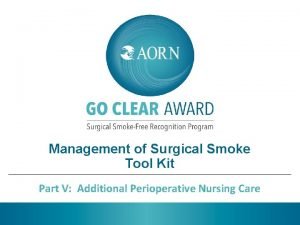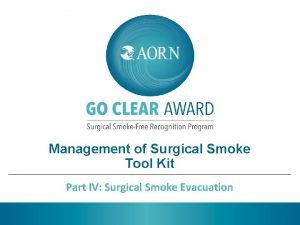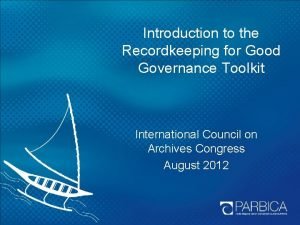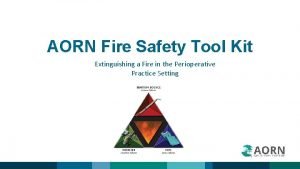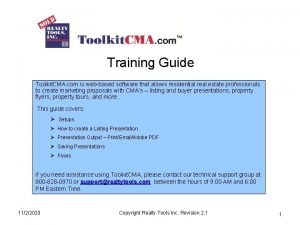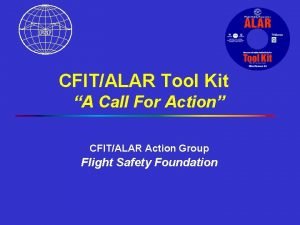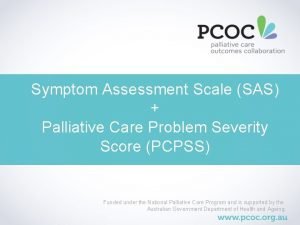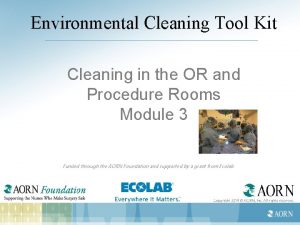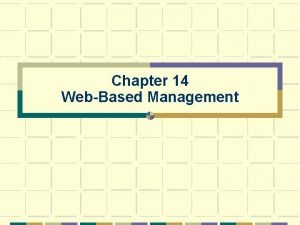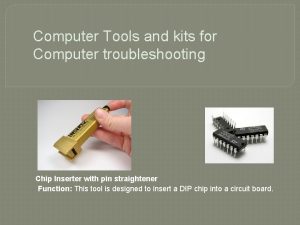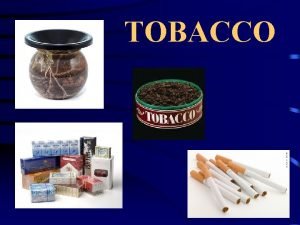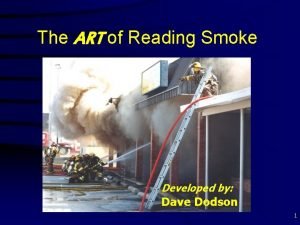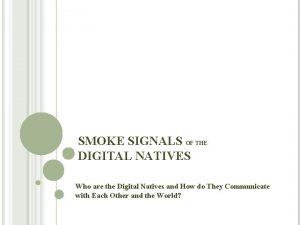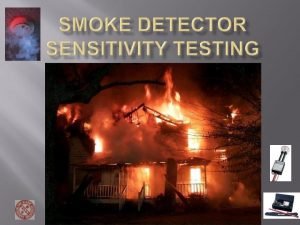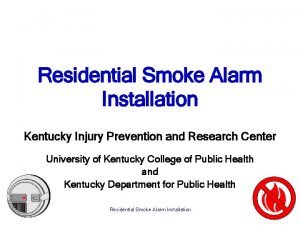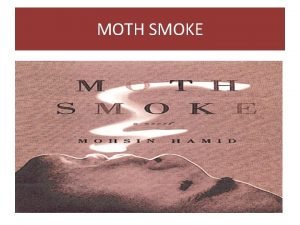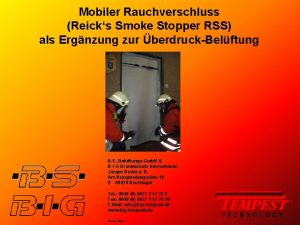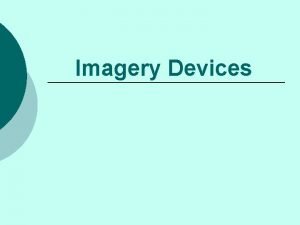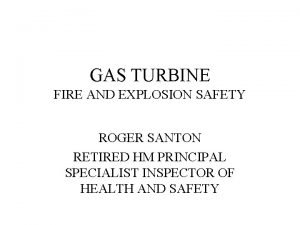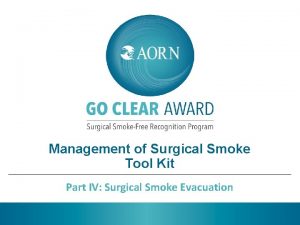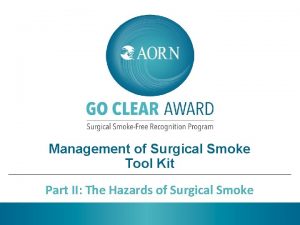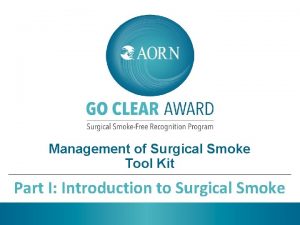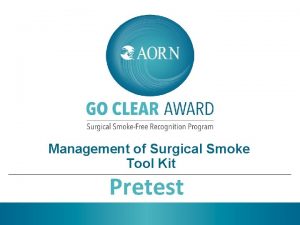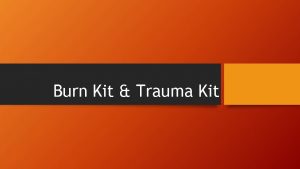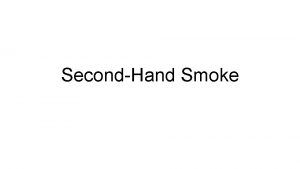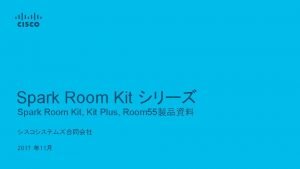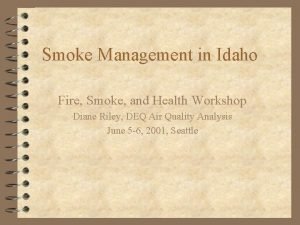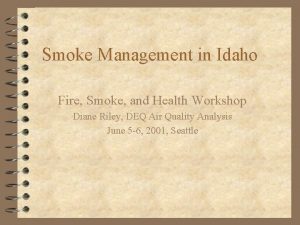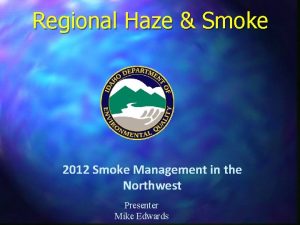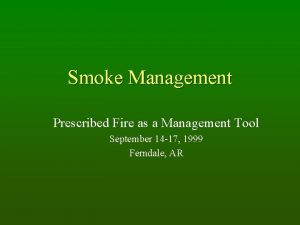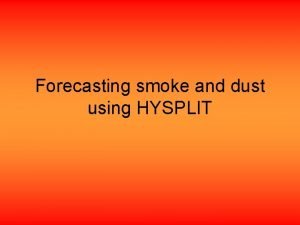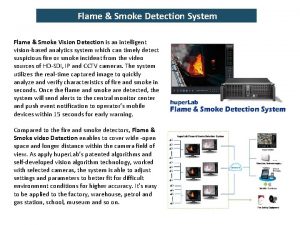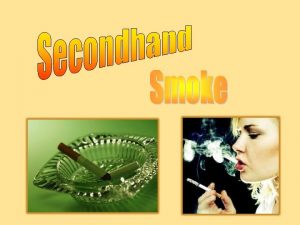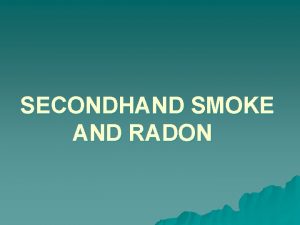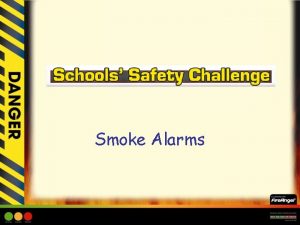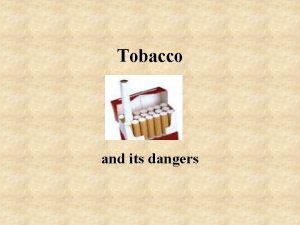Management of Surgical Smoke Tool Kit Part V






























- Slides: 30

Management of Surgical Smoke Tool Kit Part V: Additional Perioperative Nursing Care

Instructions to the Learner This tool kit contains five slide decks related to the management of surgical smoke in the perioperative setting. We recommend that you review the slide decks in order. This is Part V. • Part I: Introduction to Surgical Smoke • Part II: Hazards of Surgical Smoke • Part III: An Overview of Health Care Regulations, Standards, and Guidelines Related to Surgical Smoke • Part IV: Smoke Evacuation in the Perioperative Setting • Part V: Additional Perioperative Nursing Care

Part V Additional Perioperative Nursing Care

Perioperative Nursing Care

Perioperative Nursing Care • Patient assessment • Will your patient be exposed or potentially be exposed to surgical smoke? • Diagnosis • Planning care • Interventions and evaluation of outcomes • Patient outcomes

Surgical Attire Remember that general room ventilation and smoke evacuation are the first line of protection from surgical smoke. Wear appropriate PPE.

PPE: Masks Surgical masks and high-filtration surgical face masks • Fluid resistant, loose-fitting face mask • Protects wearer from large droplets, splashes, sprays • Not a reliable way to protect wearer from inhaling contaminants • Does not create a seal between the wearer’s face and the mask

PPE: Masks High-filtration surgical face mask • Designed to filter particulate matter that is 0. 1 micron in size or larger A surgical mask is not considered respiratory PPE.


Respiratory Protection Wear PPE (ie, respiratory protection) as secondary protection from surgical smoke. • Minimum requirement is a fit-tested surgical N 95 filtering face piece respirator (ie, N 95 respirator) Wear an N 95 respirator during • Higher-risk, aerosol-generating procedures • Procedures on patients known or suspected to have aerosol transmissible diseases • tuberculosis (TB), varicella, rubeola

Respiratory Protection Wear a fit-tested surgical N 95 filtering face piece respirator for • disease transmissible cases (eg, human papillomavirus [HPV]) • aerosol transmissible diseases (eg, TB, varicella, rubeola) • aerosol-generating procedures (eg, bronchoscopy)

Team Briefing • Communication with the surgeon and perioperative team members • Plan for smoke evacuation • Equipment and optimal placement of equipment • Smoke protection methods for the patient and team members

Hand-Over Communication • Include PPE and respiratory protection/mask options • Type of smoke evacuation method being used

Safe Handling • Use standard precautions when disposing of used smoke filter devices and other used smoke equipment.

Documentation Relevant information about smoke evacuation and equipment used

Policies and Procedures • Address best practices for the patient and the perioperative team • National regulatory and professional standards • Credentials, competency, and training • Equipment • Operational guidelines • Patient and health care worker incidents

Smoke Evacuation: Compliance Study • Surgical smoke compliance study 2009 • To identify key indicators of compliance with surgical smoke evacuation recommendations

Smoke Evacuation Compliance Study: Compliance Model* Individual Innovativeness Characteristics Perceptions of Attributes (Nurses’ perceptions of smoke evacuation recommendations) (Perioperative nurse characteristics) Age Relative advantage Education level Compatibility Experience Complexity Knowledge Trialability Training Observability Presence of respiratory problems Barriers to practice Organization Innovativeness Characteristics (Organization’s characteristics) Descriptors (locale, type) Size Complexity Formalization Interconnectedness Leadership support Barriers to practice No compliance Compliance with research-based smoke evacuation recommendations Full compliance * Based on Roger’s Diffusion of Innovations model. Reprinted with permission from Kay Ball, Ph. D, RN, CNOR, FAAN.

Smoke Evacuation Compliance Study Key indicators of compliance • Education • Leadership support • Easy to follow policies • Regular internal collaboration

Perioperative RN Survey • • • November 2010 Survey e-mailed to current, active members of AORN North American health care facilities 1, 356 responses/10, 000 emailed requests Compared findings from 2007 similar study

Perioperative RN Survey: Study Findings • The use of wall suction during laser procedures (excepting laser hair removal and LASIK) is similar to that for electrosurgery, electrocautery, diathermy, or ultrasonic scalpel procedures. • There is a lower incidence of smoke evacuator use than wall suction use. • The smoke evacuator use rates did not change significantly between 2007 and 2010. • Few facilities routinely used effective respiratory protection for surgical smoke.

Educational Outcomes and Competency • Define surgical smoke. • Describe critical factors for managing surgical smoke for all procedures that generate surgical smoke. • Describe the health effects of smoke exposure on patients and health care workers.

Educational Outcomes and Competency • Explain the effect of particle size on the speed and distance smoke travels. • Identify sources of surgical smoke: • Lasers • ESUs • Ultrasonic devices • High-speed drills • Burrs • Saws

Educational Outcomes and Competency • Participate in quality improvement programs related to the management of surgical smoke as assigned. • Review policies and procedures related to smoke evacuation. • Follow manufacturer’s instructions for use when cleaning, maintaining, and decontaminating smoke evacuation equipment.

Educational Outcomes and Competency • Smoke Evacuation Equipment • Select smoke evacuation systems and supplies in accordance with the procedure being performed. • Test smoke evacuation equipment before the procedure. • Connect equipment correctly. • Use smoke evacuation equipment correctly during the procedure. • Used Smoke Evacuation Equipment Supplies • Use standard precautions to handle used smoke evacuation supplies. • Discard biohazardous waste.

Increasing Compliance Provide information and activities to help increase compliance with best practices for the management of surgical smoke. • Quality and Safety Committee reports • Educational programs • • • perioperative nursing care • research on the hazards of surgical smoke • equipment and supplies Safety signs AORN posters Checklists Monitor practices

Quality Monitoring and Performance Improvement – Compliance Indicators Is surgical smoke: • evacuated with a smoke evacuator, a laparoscopic filter, or suction with an in-line filter during all smoke-generating procedures? Is the smoke evacuation capture device: • positioned as close as possible to the generation of surgical smoke to effectively collect all traces of the smoke? Is an additional standard suction used to evacuate fluid?

Quality Monitoring and Performance Improvement – Compliance Indicators Are smoke evacuation filters being used: • according to manufacturer’s instructions for use? Are perioperative team members: • wearing PPE when disposing of contaminated filters and smoke supplies? • adhering to policies and procedures for smoke evacuation? It is important to: • measure smoke evacuation practices by direct observation • identify barriers to smoke evacuation practices • Hospital personnel can develop interventions to address barriers identified

Are Hospitals Really Smoke Free? • Thousands of hospitals make that claim. • Let’s advocate to make the perioperative setting smoke-free as well. Protect Patients – Colleagues – Ourselves from the Hazards of Surgical Smoke http: //www. cdc. gov/vitalsigns/Tobacco. Use/Smoking/index. html

The End Congratulations!
 Managing surgical smoke
Managing surgical smoke Aappm
Aappm Surgical plume evacuator tool
Surgical plume evacuator tool Strikethrough sterile field
Strikethrough sterile field Sanctuary 7 commitments
Sanctuary 7 commitments Esu pencil
Esu pencil Corporate governance tool kit
Corporate governance tool kit Aorn fire risk assessment tool
Aorn fire risk assessment tool Strategic workforce planning toolkit
Strategic workforce planning toolkit Tool kit cma
Tool kit cma Cfit alar
Cfit alar Tool kit learning walk
Tool kit learning walk Sas scale
Sas scale Ecolab housekeeping tool kit
Ecolab housekeeping tool kit Java dynamic management kit
Java dynamic management kit Potter's tool is data cleaning tool
Potter's tool is data cleaning tool Function of tweezers in computer
Function of tweezers in computer Sidestream smoke
Sidestream smoke Dave dodson reading smoke
Dave dodson reading smoke Digital smoke signals
Digital smoke signals Fire smoke robot
Fire smoke robot Walter jaeger smoke detector
Walter jaeger smoke detector Smoke past tense
Smoke past tense Smoke detector use
Smoke detector use If you were to blow smoke into the space between
If you were to blow smoke into the space between Moth smoke detector
Moth smoke detector Test 04
Test 04 Smoke stopper
Smoke stopper Smoke signals communication
Smoke signals communication Writers use imagery to
Writers use imagery to Iso 21789 pdf
Iso 21789 pdf
